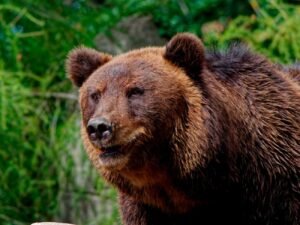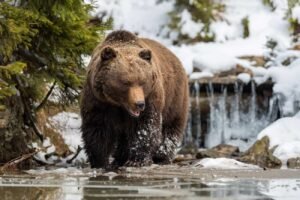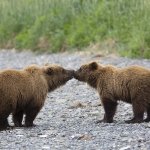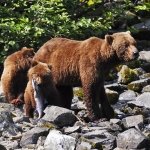Safety Guide to Bears
British Columbia has about one-quarter of all black bears in Canada, and half of all grizzly bears. Seeing a bear in British Columbia can be one of the most memorable experiences of a wilderness vacation, but it is our responsibility to respect the bear in its home. This means we must not force bears to leave their habitat, teach them to eat human foods, or place bears in situations where people or bears could get hurt. Preparation and education are essential to ensure that our encounters with bears in the wilds of BC are positive and free from conflict.
Bears are everywhere. We see them on the side of the highway, on logging roads, on the way to a campsite, near towns, or in the bush when hiking or working. Bears will usually hide from people, but remember: just because you don’t see a bear, doesn’t mean they aren’t around.
Until recently there were no grizzly bears on Vancouver Island, and there are few or no grizzlies in the heavily settled Lower Mainland or the dry, southern areas of British Columbia. As far as anyone can remember, or scientists can determine, only black bears have lived on Vancouver Island.
But recently, grizzlies have been sighted far and wide on northern Vancouver Island and the knot of smaller islands that press close against the coast between Port Hardy and Campbell River. Officials suspect three or four sub-adult male grizzlies are responsible for the year’s sightings, having paddled and island-hopped their way westward from the B.C. mainland.
Safety Guide to Bears: Safety essentials when in Bear country
- Each bear encounter is unique. No hard and fast rules can be applied when dealing with a potentially complex situation.
- Respect all bears – they all can be dangerous. Be alert.
- Never approach a bear, especially bear cubs. Avoid conflict by practising prevention.
- There is no guaranteed minimum safe distance from a bear – the further, the better.
- Photographing bears can be dangerous. Use a long- range telephoto lens.
- Never attempt to feed a bear. Stay away from dead animals, as bears may attack to defend such food.
- Be defensive – never surprise a bear. Make your presence known by talking loudly, clapping, singing, or occasionally calling out.
- Look for signs of recent bear activity. These include droppings, tracks, evidence of digging, and claw or bite marks on trees.
- It is best not to hike with dogs, as they can antagonize bears and cause an attack. An unleashed dog may bring a bear back to you.
- Learn about bears. Anticipate and avoid encounters. Know what to do if you encounter a bear.
- Odours attract bears. Reduce or eliminate odours from yourself, your camp, your clothes, and your vehicle. Don’t sleep in the same clothes you cook in. Properly store food, including pet food, so that bears cannot smell or reach it. Don’t keep food in your tent – not even a chocolate bar. Pack out all garbage.
Safety Guide to Bears: The most dangerous bears are
- Bears habituated to human food.
- Females defending cubs.
- Bears defending a fresh kill.
- Cute, friendly, and apparently not interested in you.
Safety Guide to Bears: About bears
- Bears can run as fast as horses uphill or downhill.
- Bears can climb trees, although black bears are better tree-climbers than grizzly bears.
- Bears have excellent senses of smell and hearing, and better sight than many people believe.
- Bears are strong. They can tear cars apart looking for food.
- Every bear defends a “personal space”. The extent of this space will vary with each bear and each situation; it may be a few metres or a few hundred metres. Intrusion into this space is considered a threat and may provide an attack.
- Bears aggressively defend their food.
- All female bears defend their cubs. If a female with cubs is surprised at close range or is separated from her cubs, she may attack. An aggressive response is the mother grizzly’s natural defence against danger to her young.
- A female black bear’s natural defence is to chase her cubs up a tree and defend them from the base. However, she is still dangerous and may become aggressive if provoked.
If you encounter a bear at the roadside:
- Remain in your vehicle. Don’t get out even for a “quick photo”.
- Keep your windows up.
- Do not impede the bear from crossing the road.
- If you park to view bears at a distance, leave your car well off the road to avoid accidents
Resources:
1. https://wildsafebc.com](https://wildsafebc.com
2. https://wildsafebc.thinkific.com](https://wildsafebc.thinkific.com









